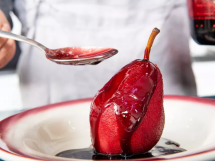
Come into my apartment, and you’ll see many bottles of wine on my dining table. My husband imports Portuguese wine and often samples it at restaurants, bars, and wine stores. Usually, the leftover wine goes to our neighbors, but if I feel creative, I use it in dishes like braised short ribs or risotto, or for poaching winter fruits like pears.
Red wine poached pears — poire à la Beaujolaise — are a classic French dessert found in small restaurants and bars. Pears are simmered (煨) with red wine, sugar, and sometimes warm spices until tender, then served with their poaching liquid. It’s an easy dessert that’s fancy enough for a dinner party and simple enough for a weeknight. Plus, you can make it up to three days ahead. The pears soak up a lovely burgundy color from the poaching liquid.
Though traditionally made with Beaujolais, a fruity red wine from Gamay grapes, almost any red wine works fine here. The type of pear matters less than its ripeness. You want them just ripe and slightly soft but not so tender they fall apart during poaching. I like Bartlett and Starkrimson pears — they are juicy and when ripe, soften while keeping some firmness, making them perfect for cooking. Their skins change color as they ripen, giving you a good idea when they’re ready: Bartlett pears turn yellow, while Starkrimsons become brighter red. When unsure, feel your pears and smell them — they should give slightly when gently pressed and smell sweet.
To give my poached pears a flavor like wintry mulled wine, I add fresh orange peel, a cinnamon stick, cloves, black peppercorns, and star anise (八角香料) to the wine. Just enough to give a warm spiced note without overwhelming the pears. While delicious with their poaching liquid, I like to reduce the wine for a thicker sauce. After removing the spices, I simmer the poaching liquid until it thickens into a glaze, then spoon it over the pears. Enjoyed alone or with vanilla (香草) ice cream or sauce, it makes me feel like I’m in a warm and comfortable French bistro — even if I’m just on my couch.
原创编写 版权所有 侵权必究! 每日更新 个性化阅读 英语飙升!
1.1.How does the author lead into the topic?
A By listing figures.
B By describing a scene.
C By giving examples.
D By making a comparison.
解析:选B。B 推理判断题。根据第一段描述的“走进我的公寓,你会看到我的餐桌上有很多葡萄酒”这一场景可知,作者通过这个场景来引出下文的话题:用红酒来烹饪美食。故选B。
2.2.Poire à la Beaujolaise is ________.
A an Italian dessert
B for holidays only
C cooked with milk
D prepared with red wine
解析:选D。D 细节理解题。根据第二段中的“a classic French dessert”可知A项错误;根据“Pears are cooked with red wine”可知C项错误,D项正确;根据“for a dinner party”“for a weeknight”可知B项错误。故选D。
3.3.What is crucial for making poire à la Beaujolaise?
A Types of wine.
B Heat control.
C Ripeness of pears.
D Types of pears.
解析:选C。C 细节理解题。根据第三段中的“almost any red wine works fine here”可知A项错误;根据“The type of pear matters less than its ripeness”“You want them just ripe and slightly soft but not so tender they fall apart during poaching.”可知C项正确,D项错误;文章未提及火候是最重要的。故选C。
4.4.What does the underlined word “bistro” mean?
A A bar.
B A shop.
C A farm.
D A beach.
解析:选A。A 词义猜测题。根据第二段中的“Red wine poached pears — poire à la Beaujolaise — are a classic French dessert found in small restaurants and bars.”可知,红酒梨是法国小餐馆和小酒馆的一道经典法式甜点。可猜测,这里的bistro指的是(法国的)小餐馆或小酒馆。故选A。
